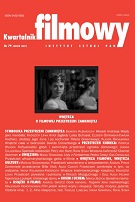Postindustrialny soul, czyli przestrzeń afroamerykańskiego getta w filmie.
Postindustrial soul or the space of Afro-American ghetto in film.
Author(s): Ewa DrygalskaSubject(s): Theatre, Dance, Performing Arts
Published by: Instytut Sztuki Polskiej Akademii Nauk
Keywords: Van Peebles; Melvin; Davis; Ossie; Parks; Jr; Gordon; Singleton; John; Hughes brothers; Afro-American cinema; inner-city ghettos; mainstream American cinema; blaxploitation; black realism; origin of the ghetto; "Cotton Comes to Harlem".
Summary/Abstract: Contemporary Afro-American cinema, from the 1970s up to most recent productions, is irrevocably tied with the creation, development and evolution of American cities and inner-city ghettos – spaces occupied by certain ethnic groups. Drygalska tracks representations and images of such spaces in mainstream American cinema from the genre of blaxploitation to the new black realism. By placing the film in the sociohistorical context, the author explores the problem of the origin of the ghetto and how it became an emblem of African-American culture in popular culture. Drygalska focuses on films such as: "Cotton Comes to Harlem" (dir. Ossie Davis), "Sweet Sweetback’s Baadasssss Song" (dir. Melvin Van Peebles), "Super Fly" (dir. Gordon Parks, Jr.), "Boyz N the Hood" (dir. John Singleton) and the "Menace II Society" by the Hughes brothers.
Journal: Kwartalnik Filmowy
- Issue Year: 2012
- Issue No: 79
- Page Range: 120-138
- Page Count: 19
- Language: Polish

